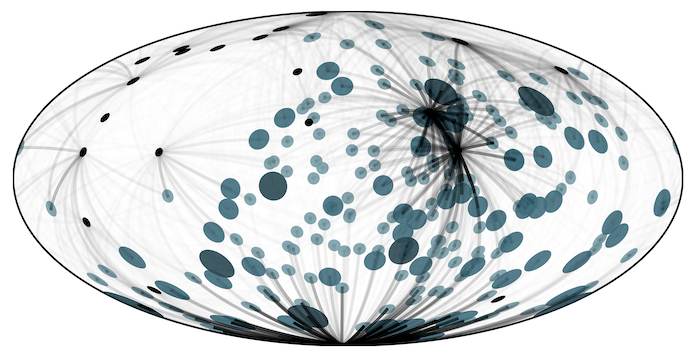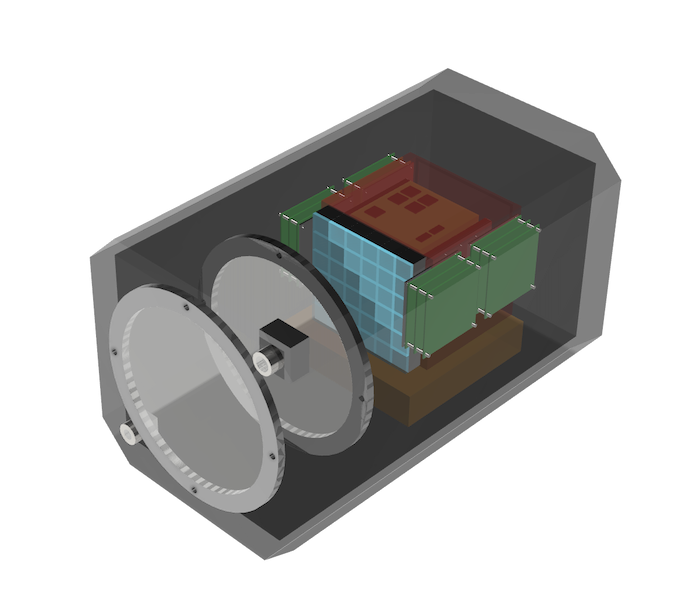Research
My research focuses on understanding the origins of the highest energy particles ever detected, ultra-high-energy cosmic rays (UHECRs). Because of their huge energies, they are thought to be accelerated in energetic astrophysical sources outside of our own Galaxy, but the exact nature of these sources remains unknown. UHECRs produce neutrinos and photons when they interact with matter and radiation fields as they leave their sources and travel through the universe towards us. In this way, we can also study signals from these other "messengers" to deepen our understanding. I have worked on both new detector technologies that will allow us to detect more of these rare particles and data analysis techniques to fully exploit all the available information in the search for their sources. These days, I'm particularly interested in how Bayesian statistical methods and multi-messenger approaches can be used to give new insights into UHECR phenomenology and other long-standing problems in astrophysics.
I summarise some of my recent work below. A full publication list can be found on Google Scholar or ADS.
Assessing coincident neutrino detections
Several associations between high-energy neutrinos and astrophysical sources with a statistical significance of around 3 sigma have been recently reported, but a conclusive identification of these sources remains challenging. We use Monte Carlo simulations of source populations in the popsynth framework to gain deeper insights into these proposed source-neutrino associations. Focusing on the particular case of the association between the high-energy neutrino alert IC170922A and the gamma-ray blazar TXS 0506+056, we find that for this detection to make sense, the connection between the neutrino and gamma-ray fluxes must be constrained to small values.
Paper: Capel, F., Burgess, J. M., Mortlock, D. J. & Padovani, P., 2022. Assessing coincident neutrino detections using population models. Submitted to Astronomy & Astrophysics, arXiv:2201.05633.
Constraining astrophysical neutrino sources
The IceCube neutrino observatory has detected an astrophysical flux of high-energy neutrinos but has not been able to resolve any point sources. This situation is expected, as neutrinos can reach us from vast distances, with the majority of the observed flux due to the integrated contribution of many sources. These observations can be leveraged to place constraints on the properties of a general source population. We have developed a flexible framework for the calculation of these constraints that goes beyond previous work by including a realistic model for the detection of point sources in IceCube. These ideas can be extended to investigate specific source classes in detail or bring in other information from UHECRs or gamma-ray measurements that could be used to enhance the constraints.
Paper: Capel, F., Mortlock, D. J. & Finley, C., 2020. Bayesian constraints on the astrophysical neutrino source population from IceCube data. Physical Review D, 101, pp.123017, 10.1103/PhysRevD.101.123017.
A hierarchical model for UHECR associations
We have developed a Bayesian hierarchical model which enables a joint fit of the UHECR energy spectrum and arrival directions within the context of a physical model for the UHECR phenomenology. Using this approach, we see a higher associated fraction than other work, but the simple physical model is still not able to explain the cosmic rays at the very highest energies, which are the most constraining. This work has been shortlisted for the American Statistical Association's Best Astrostatistics Student Paper Award. The code is open source and documented for reproducibility.
Paper: Capel, F. & Mortlock, D. J., 2019. Impact of using the ultrahigh-energy cosmic ray arrival energies to constrain source associations. Monthly Notices of the Royal Astronomical Society, 484(2), pp.2324–2340, 10.1093/mnras/stz081.
The Mini-EUSO instrument
The Mini-EUSO instrument is a small UV telescope that was recently launched to the International Space Station. It is designed to prepare for the space-based fluorescence detection of UHECRs. If successful, this technique will be able to dramatically increase the number of UHECRs we are able to observe, thanks to the increase in effective area that comes with being able to view large amounts of the Earth's atmosphere from space.
I am involved in this project as part of the international JEM-EUSO Collaboration. My contributions include the integration and testing of the instrument hardware and the design and implementation of the level 2 trigger algorithm. I am also responsible for the instrument data acquisition and control software which I have released as open source with extensive documentation.
Software paper: Capel, F. et al., 2019. Mini-EUSO (Extreme Universe Space Observatory) data acquisition and control software. The Journal of Astronomical Telescopes, Instrumentation and Systems, 5(4), pp.044009, 10.1117/1.JATIS.5.4.044009.
Instrument paper: Capel, F. et al., 2018. Mini-EUSO: A high resolution detector for the study of terrestrial and cosmic UV emission from the International Space Station. Advances in Space Research, 62(10), pp.2954-2965, 10.1016/j.asr.2017.08.030.
PhD thesis
My PhD thesis, Cosmic clues from astrophysical particles, explores different ideas with the underlying goal of reaching a deeper understanding of the astrophysical particles that we detect on Earth. Part I focuses on the development of a space-based observatory for ultra-high-energy comsic rays, and Part II investigates advanced analysis techniques that can be applied to existing data. These two approaches are complementary and the results presented motivate further investment in both directions in order to progress. For the cover, I played around with some generative art, and you can have a go yourself in this Observable notebook.





